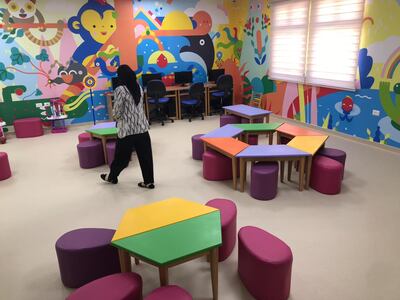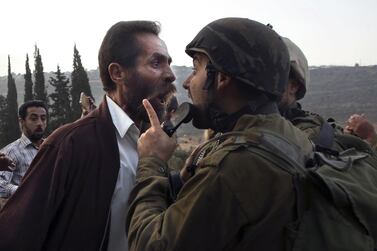Gazan five-year-old Sohaib Inaazi lost his hair from the treatment for leukemia but what distressed him more was having to travel alone to Israel.
"We suffered a lot in sending him to Hebron hospital," in the West Bank, his mother Sohaib told The National from his bedside last week. "Israeli authorities denied me and his father permission to go with him so he suffered a lot psychologically."
Until recently child cancer patients in the blockaded enclave had to seek permission from Israeli authorities to travel to the West Bank for life-saving care. But this week Sohaib will take a space in a new 16-bed, 2,400 square metre children’s cancer department, which occupies a new floor at Gaza’s pediatric hospital.
Funded with a $3 million grant from American NGO Palestine Children’s Relief Fund, the new department will treat children with blood cancer and related diseases, saving them from making the difficult journey to Israel or the West Bank for treatment, often without their parents.

An average of 80 Gazan children require treatment for cancer each year. However, now those with leukemia and thalassemia – about 80 per cent of young cancer patients – will be treated in Gaza, according to Steve Sosebee, PCRF’s president.
"We are proud of that because now these children do not have to be separated from their families and don't have to have fragmented care which can be broken any time due to regulations of travel," Mr Sosebee told the Associated Press.
Some patients will still have to travel for treatment, including those who require bone marrow transplants, radiation therapy and nuclear medicine. Mr Sosebee said that in the future, the department hopes to increase its capacity to treat more difficult cases by bringing in outside experts to train the local staff.
There is no bone-marrow transplant program yet in Palestine for children with cancer but we are starting the process of building one by bringing experts like Dr. Prasad here to help train our local staff. https://t.co/Vea0IFkwRM
— Steve Sosebee (@Stevesosebee) February 24, 2019
Israel and Egypt have blockaded Gaza’s 2 million inhabitants since the militant group Hamas took power in 2007. Amid a devastated economy, the strip’s healthcare sector has been particularly hard-hit.
Thousands of Gazans seek permission to travel to Israel for medical care each year. But the security clearances required for travel are not always forthcoming, particularly for Palestinian adults under 50, meaning parents are often prevented from travelling with their sick children.
Only 61 per cent of applications for travel for medical treatment were approved on time last year, according to the World Health Organisation, 31 per cent were answered late or not at all, and the rest rejected.
Cogat, the Israeli defence body that gives permissions, said it issued 33,000 permits to Gazan medical patients last year, although it did not have say how many children were included.
A report released by the Palestinian Human Rights Centre to coincide with Child Cancer Day on this month outlined the challenging conditions to providing medical care in Gaza. These include a lack of facilities, medicine, supplies, diagnostic and therapeutic devices, a lack of oncologists and even a reliable electricity supply in Gaza’s hospitals.
However, the new department has significantly improved the treatment options for child cancer patients, according to the department’s head Dr Mahmoud Shbeer. “The department is prepared well to protect children from infections so each patient has his own room, and each room has professional equipment that can monitor the status of patient and provide the suitable treatment immediately,” he said.
The department will be staffed by two resident doctors and also contains a pharmacy and dental clinic.
Rooms are brightly coloured and filled with toys to give patients a sense of normalcy, and three teachers will offer children an opportunity to continue their education while they receive treatment.






